The Sapporo International Art Festival 2020 (SIAF2020), which was being prepared to begin in December 2020, was cancelled due to the effects of the novel coronavirus (COVID-19). However, it launched a special edition website on December 19, 2020, the original opening date. The project was developed across a variety of media, including YouTube, exhibition display and a book. What did SIAF2020 aim to achieve in the face of the coronavirus? AMANO Taro, Curatorial Director of Contemporary Art/Director in Chief of the Sapporo International Art Festival 2020, looks back.
 Moerenuma Park, one of SIAF2020’s planned venues
Moerenuma Park, one of SIAF2020’s planned venues
The past two editions were held in summer, but SIAF2020 was to be held in winter in snowy Sapporo.
Photo: TAKUMA Noriko
A concept that crosses the boundaries of art
The Sapporo International Art Festival (SIAF), which began in 2014, is a triennial art festival held every three years, with the third edition slated for 2020 following the 2017 edition. In order to present SIAF’s unique character, the starting season was carefully planned and initially held in summer when the beauty of nature would be evident. However, for the third edition, the event period was shifted to winter, when the location in Sapporo in Hokkaido would take advantage of its distinctive snowy landscape.
In addition to showing off the features of the host city, Sapporo, the art festival has focused on media art as a main pillar of its content and has taken into account current trends. As part of the “sapporo ideas city” initiative, it has set a policy of being a creative city, as many other municipalities in Japan have done. The city has aimed to become a member of the UNESCO Creative Cities Network (UCCN). In November 2013, Sapporo was named as a member in the field of media arts. It was the second city in the world and the first in Asia with the designation. For an art festival, it is essential to include media art and the field of so-called “fine arts.” For the third edition of the art festival, it was important to create a concept that transcended the boundaries between media art and fine art.
Twenty years into the 21st century, we have moved from the analog era to a full-fledged digital society, including the development of social infrastructure, and IoT and AI are generally having a far-reaching impact on our daily lives. The same is true for media art. The concept of interactive works shows a shift from the days when we relied on devices as technology to an operational system that controls them.
As media art began to change in the digital age, an analog realm of fine art also faced a number of challenges. The key concept that has supported fine art, or modern and contemporary art, has been a clear delineation of originality and copying. For example, in Japan, plaster casts of bronze sculptures have been designated as national treasures and important cultural properties. In other words, a plaster mold is the original, and the bronze statue created from it is a copy. In fact, the plaster cast of OGIWARA Morie’s bronze sculpture, Woman (1910), is designated as an important cultural property.
 Left: Woman by OGIWARA Morie
Left: Woman by OGIWARA Morie
Right: Plaster cast of Woman by OGIWARA Morie (Important cultural property)
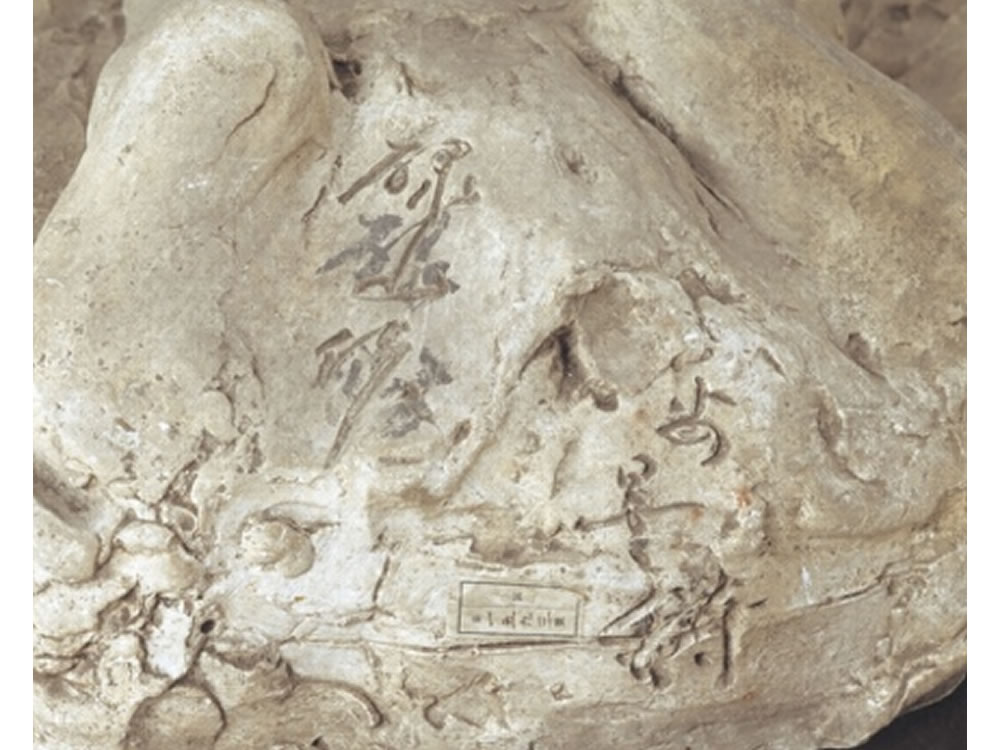 Back of the plaster cast pedestal
Back of the plaster cast pedestal
Even in photography, a reproduction technology that emerged in the 19th century, the relationship between original and reproduction can be seen in the film and the prints produced from it.
On the other hand, with the advent of digital technology, what corresponds to film in analog photography and video works has now become data. The data in a form of information in binary (the binary system) = artwork. Here, uniformity of a form of content also dissolved the independence of a field (such as photography and video), which was another important concept of modernism. Due to differences in types of equipment (e.g., cameras) and versions of operating systems and applications used to run the equipment at the time, these digital works also posed new challenges for preservation and management. One form of evidence is that people are facing the problem that images once captured digitally are now difficult to play back due to differences in the versions of the devices and operating systems that play them back.
As already mentioned, reproduction of original data in the digital age is not reproduction but content identical to the original, thus nullifying the former analog hierarchy of original and reproduction. These challenges and responses to the digital age on various levels are now an important part of the theme of SIAF2020.
Informing media art as something familiar
With this theme in mind, Agnieszka KUBICKA-DZIEDUSZYCKA, Curatorial Director of Media Art, SIAF2020, a Polish curator (at the WRO Center for Media Art Foundation), proposed to present Senster (a portmanteau of “sensitive” and “monster”) as one of the works to be exhibited. This work is a kinetic sculpture created by Edward IHNATOWICZ, a sculptor of Polish origin working in London. Introduced in 1970, it is considered a masterpiece in the history of new media art. Commissioned by Philips, one of the leading electrical equipment manufacturers at the time, Senster was exhibited at its science and technology exhibition hall, Evoluon, in Eindhoven, the Netherlands, from 1970 to 1974. Although a pioneering example of media art that foreshadowed today’s digital society, it was believed lost and forgotten for many years after it was exhibited. In 2014, satellite images revealed its body in Colijnsplaat, Zeeland, in the southwestern Netherlands. Then, a project to reactivate Senster was born, led by Anna OLSZEWSKA, a research fellow at the AGH University of Science and Technology in Krakow, Poland, leading to this exhibition.
It is a five-meter-long steel work whose movements are controlled by a computer by utilizing the most advanced robotics, artificial life, and artificial intelligence technologies of the time. According to Anna OLSZEWSKA, who directed the project, IHNATOWICZ ingeniously incorporated the concepts of feedback loops and control engineering into an original form of a time-based work of art—a cybernetic sculpture. In an attempt to introduce the background of this period from multiple perspectives, SIAF2020 invited OLSZEWSKA and MA Jung-Yeon, who is known for her research on media art, as advisers, and planned a related exhibition that would take into account the perspectives of media art in Japan at the time.
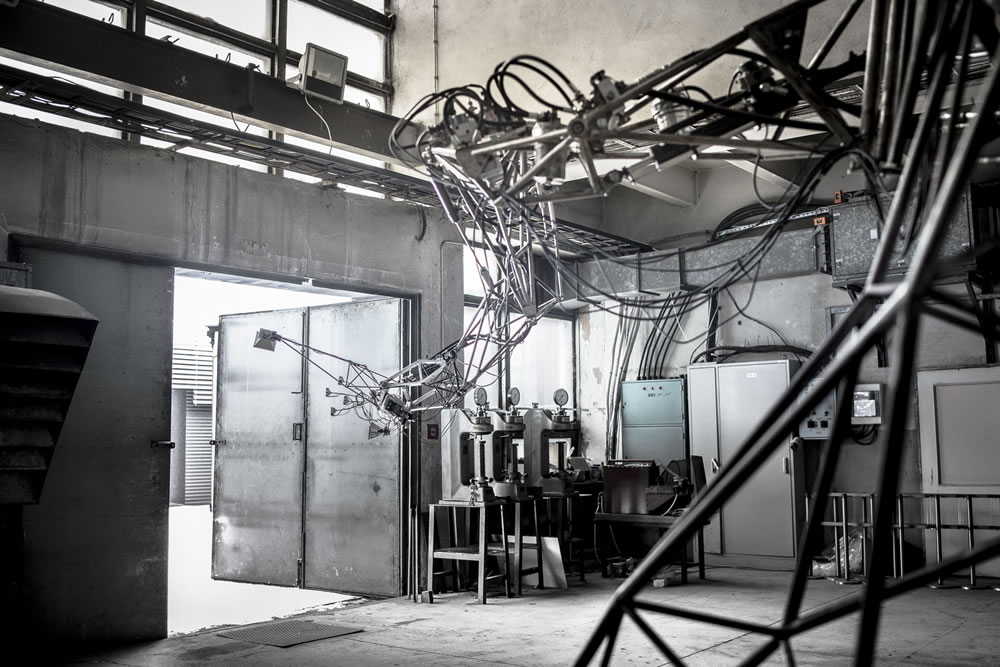 Senster in the production studio of AGH University of Science and Technology, 2019
Senster in the production studio of AGH University of Science and Technology, 2019
Photo by Adam Żądło / Courtesy of AGH UST
Another interesting work and project from the perspective of the new conservation/preservation of digital artworks is MIKAMI Seiko’s Desire of Codes (2010), which was to be exhibited at SIAF2020. Unlike previous analog restorations of fine art works, such as paintings and sculptures, the difficulty of handling devices that are part of the work, and often the work itself, were highlighted.
In general, the issue of preservation and management of digital works is complicated by the issue of copyright for the work’s creator, such as how to reproduce parts of the work as they were at the time of its creation, and also how to reproduce the operating system as software, and copyright of the company producing the equipment. In any case, as people live in the current digital society, media art has become more familiar to them. SIAF2020 was conscious of how familiar the art is to those of us who live in society, rather than simply focusing on it as a field of art.
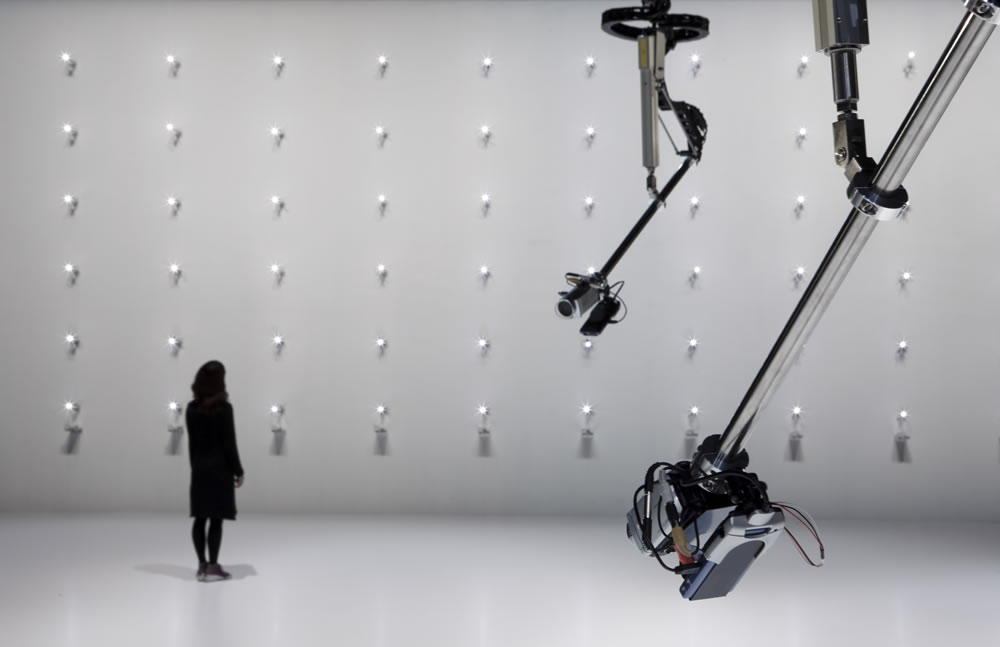 Desire of Codes, 2010, the artwork planned to be shown in SIAF2020 Photo by Ryuichi Maruo (YCAM) / Courtesy of Yamaguchi Center for Arts and Media [YCAM]
Desire of Codes, 2010, the artwork planned to be shown in SIAF2020 Photo by Ryuichi Maruo (YCAM) / Courtesy of Yamaguchi Center for Arts and Media [YCAM]
Challenges and achievements under the COVID-19 pandemic: Toward 2023
By 2018, the planning team for SIAF2020 was in place and had sufficient time to prepare. On February 7, about a year before the festival began, a press conference was held to announce a summary of the event. The first batch of participating artists and works were announced. However, before that, I personally asked the secretariat if it would be possible to go ahead with the festival, based on the experiences I encountered around that time. Although the impact of COVID-19 in Japan had not yet become serious in early February, a traveling photo exhibition, held from the end of November 2019 at an art museum in Chengdu, China, was temporarily closed due to the lockdown of the city. The exhibition was planned by Yokohama Civic Art Gallery Azamino and scheduled to be held there until February 23, 2020. (It was eventually cancelled halfway through the exhibition period.) On February 3, the news media reported that passengers of the Diamond Princess cruise ship, which had arrived at port in Yokohama, were confirmed to be infected. The situation was not optimistic.
A press conference was held. At this point, it was announced that the event would start in December of the same year, as planned.
The effects of the novel coronavirus infection later became more serious in Japan. A state of emergency was declared in April 2020, forcing many museums across the country to close for about three months. Preparations for SIAF2020 were progressing while all of this was going on. From around June, some people involved began to wonder if it would be difficult to hold the festival as scheduled. It was concluded that the event should be cancelled, and to compile a document concerning SIAF2020 covering event details, participating artists, plans and ideas of their artworks, and to publish it on the website. The cancellation was officially announced on July 22, 2020.
Since we already had a policy of communicating the entire story through various media, including websites, our workload was almost as voluminous as the preparations for the actual art festival. We used the voices of participating artists (mainly through interviews) as the main source of information, with directors and curators playing a supporting role. This was a unique opportunity to conduct a series of lengthy interviews with creators of artworks, as it is not always easy to find real voices of artists at these art festivals and museum exhibitions, even if the artworks themselves are present. In addition to web streaming distribution, a showcase titled “SIAF2020 Document” was held at the Sapporo Cultural Arts Community Center (SCARTS) from February 5 (Fri.) to February 14 (Sun.), 2021. Works that were to be exhibited featured photos and other materials, while the showcase also had messages to Sapporo from the participating artists, scenes of the preparation of the artists who had visited Sapporo in Hokkaido to create their works, still images of the Mukawa Dinasaur, whose full-body reconstructed skeleton replica was to be exhibited, and Senster. Visitors were able to experience art mediation programs and a special website at the venue. Moreover, we set up SIAF TV official YouTube program distribution studio in the venue. During the showcase, a wide range of programs was distributed live from the studio every day.
At the same time as the distribution, editing was done on the SIAF2020 Index, a document that fully features the voices of the participating artists as manuscripts, and was published at the end of March 2021, which was also a major achievement.
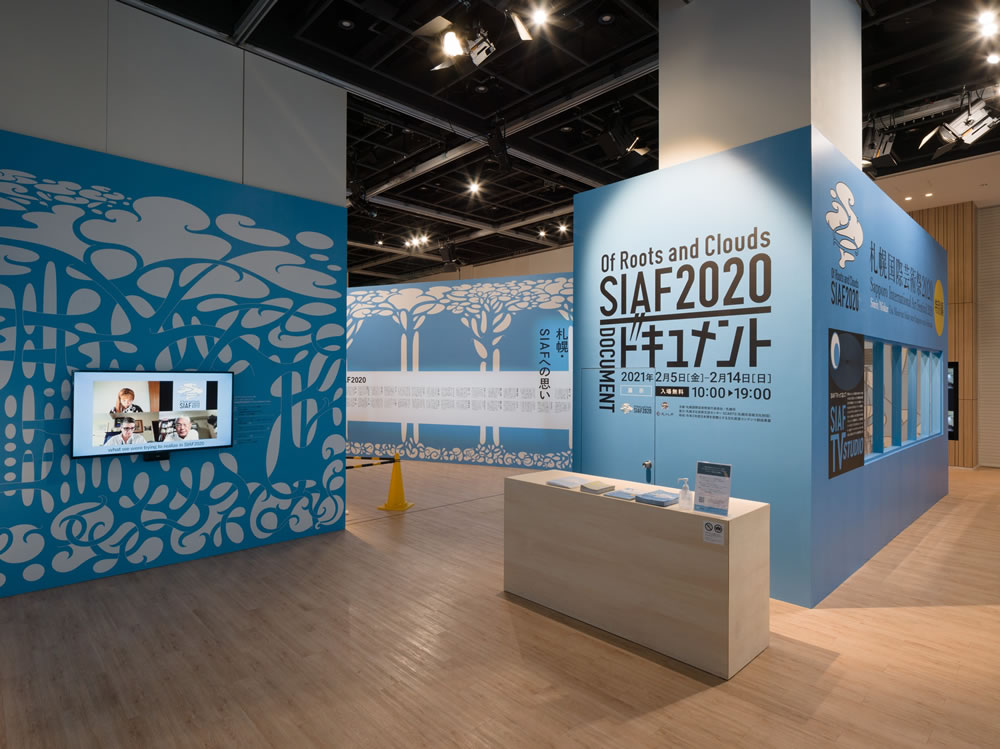 Installation view at the “SIAF2020 Document” Showcase venue
Installation view at the “SIAF2020 Document” Showcase venue
Photo: FUJIKURA Tsubasa
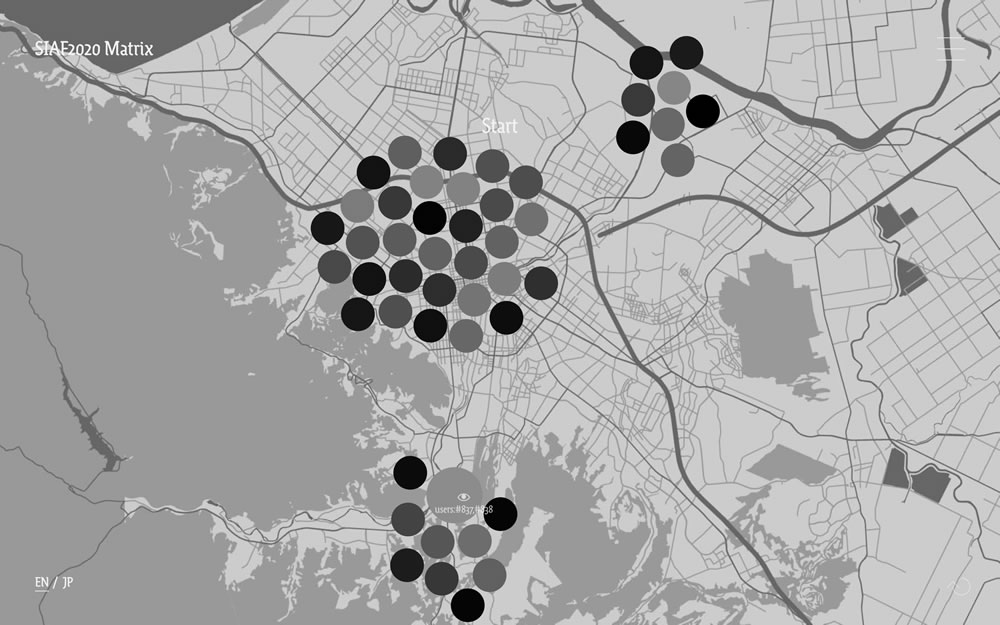 SIAF2020 Matrix was presented online as part of SIAF2020. Objects reflecting each work, which were supposed to be placed in the city of Sapporo, react interactively to users’ manipulation. According to Agnieszka KUBICKA-DZIEDUSZYCKA, SIAF2020’s Curatorial Director of Media Art, “The matrix is a prototype of an exhibition that invites visitors to read, view, and listen to various records while feeling the absence of artworks in their scheduled locations.”
SIAF2020 Matrix was presented online as part of SIAF2020. Objects reflecting each work, which were supposed to be placed in the city of Sapporo, react interactively to users’ manipulation. According to Agnieszka KUBICKA-DZIEDUSZYCKA, SIAF2020’s Curatorial Director of Media Art, “The matrix is a prototype of an exhibition that invites visitors to read, view, and listen to various records while feeling the absence of artworks in their scheduled locations.”
Co-planned and produced: Qosmo https://siaf2020matrix.jp/
SIAF2020 was indeed cancelled, but by making full use of various content and its distribution, it left its substance in an unprecedented and alternative way. At the same time, in the midst of the unimaginable circumstances of the COVID-19 pandemic, the timing of preparations, the decision to cancel the art festival, and the timing of distribution coincided with a period when the vulnerability of Japan’s digital infrastructure was unexpectedly exposed. This in itself became an issue to be deeply examined in relation to the premise for holding the festival. The fourth SIAF to be held after conquering the pandemic, which is sure to subside, will reflect on this unprecedented human experience and guide us in a new direction. I would be happy if SIAF2020 could play even a small role in bridging the gap.
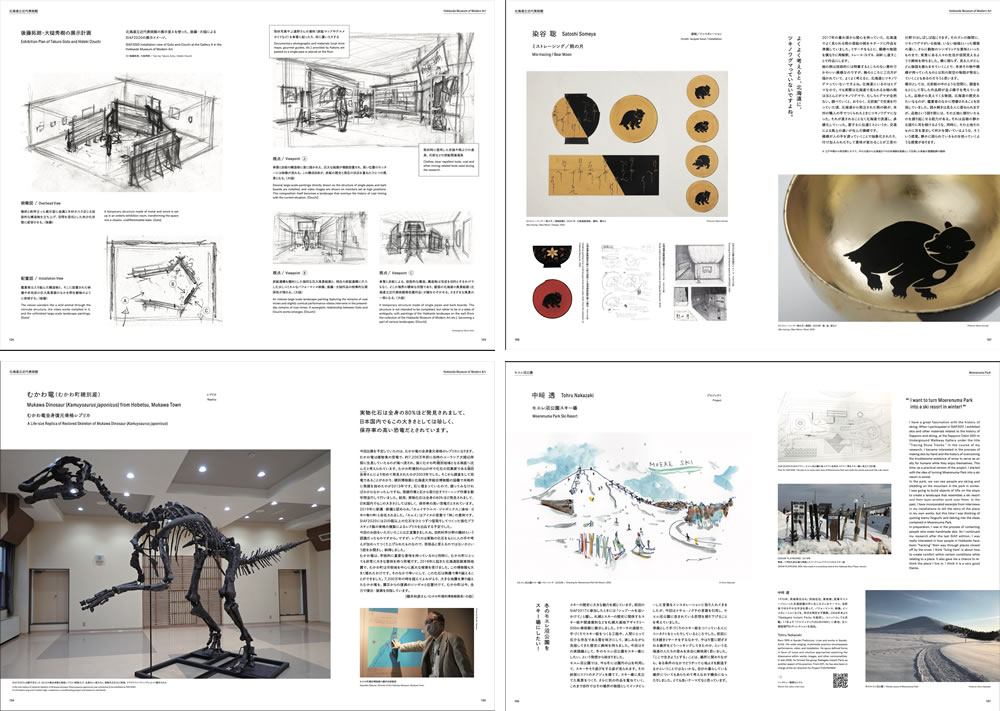 Pages from the SIAF2020 Index documents. Artists’ concepts of works were introduced with sketches and images of the works.
Pages from the SIAF2020 Index documents. Artists’ concepts of works were introduced with sketches and images of the works.
(information)
Sapporo International Art Festival2020 (SIAF2020)
Dates: Saturday, December 19, 2020–Sunday, February 14, 2021
Main Venues:
Sapporo Art Park, Sapporo Community Plaza, Hokkaido Museum of Modern Art, Migishi Kotaro Museum of Art, Hokkaido (mima), Sapporo Odori 500-m Underground Walkway Gallery, Shiryokan (Former Sapporo Court of Appeals), Moerenuma Park, Hongo Shin Memorial Museum of Sculpture, Sapporo.
*SIAF announced the cancellation of SIAF2020 on July 22, 2020.
http://siaf.jp/siaf2020/en/index.html
*URL links were confirmed on May 25, 2021.











